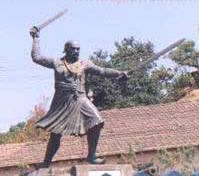Panhala, a popular fort in Kolhapur in the Maharashtra state of India , located at a majestic height of 3127 feet above sea level is an ideal getaway.The joy of experiencing the magical amalgamation of nature and history and drowning in the peace, tranquility and bliss, is possible only at a place like Panhala.
Panhala derived it's name from a tribe called Panna, meaning serpent, which initially ruled the fort. Built by King Bhoj in 1052 A.D. and ruled in succession by the Shilahara and Yadava dynasties, it was captured by Adil Shah, the ruler of Bijapur. Shahaji Bhosale was a military leader in his service. Shahaji's son Shivaji, a Maratha futurist, had steadfastly determined that he would free his land from the Bijapur rule. Training a group of dedicated soldiers in warfare, he won Panhala fort from Ibrahim Adil Shah in 1659. In 1660, Siddi Johar of Bijapur laid a long siege for four months, employing five thousand soldiers, in a fifty kilometers cordon around the fort. As supplies in the granaries started dwindling, Shivaji sent a message that he was surrendering to the enemy
12th July, 1660 was a long, rainy night, never to be forgotten in the history of Panhala! Shivaji's trusted barber, Shiva Kashid disguised himself as his master, braved gusty winds and thick fogs and proceeded in a palanquin towards Char Darwaja to pretend to capitulate. By this time, Shivaji had crept out through a window of Sajja Kothi to escape by a secret path at Raj Dindi. He hastened to travel to Vishalgad at a distance of forty kilometers. Meanwhile, realizing the deception, the Bijapur army beheaded Shiva Kashid and pursued the Maratha leader
 Shivaji's faithful ambidextrous general, Bajiprabhu Deshpande stepped into the picture. He held the enemy at bay at a narrow pass named Ghodkhind. It is said that he carried a fifteen kilogram sword in each hand! Only when bell gongs signalled that Shivaji had reached to safety, did he lay down his life on 13th July, 1660 . This pass has since been renamed Paawankhind, (Paawan means made sacred -- Bajiprabhu Deshpande made the place sacred by sacrificing his blood and hence his life for his master). As a mark of respect, a magnificent 52 kilogram bronze statue of Bajiprabhu Deshpande has been erected at the entrance of the fort. Shivaji regained the fort the next year. The Moghul ruler Aurangzeb captured it in 1700. Panhala became the state capital under Queen Tarabai until 1782
Shivaji's faithful ambidextrous general, Bajiprabhu Deshpande stepped into the picture. He held the enemy at bay at a narrow pass named Ghodkhind. It is said that he carried a fifteen kilogram sword in each hand! Only when bell gongs signalled that Shivaji had reached to safety, did he lay down his life on 13th July, 1660 . This pass has since been renamed Paawankhind, (Paawan means made sacred -- Bajiprabhu Deshpande made the place sacred by sacrificing his blood and hence his life for his master). As a mark of respect, a magnificent 52 kilogram bronze statue of Bajiprabhu Deshpande has been erected at the entrance of the fort. Shivaji regained the fort the next year. The Moghul ruler Aurangzeb captured it in 1700. Panhala became the state capital under Queen Tarabai until 1782




